
UX Design ✶ UX Research ✶ UX Testing
The Office of Religious, Spiritual, and Ethical Life at WashU is a relatively new department that encourages interfaith understanding, supports the religious, spiritual, and ethical communities on campus, and facilitates interfaith student leadership development. One way ORSEL supports the campus community is by helping students find places and moments of pause. These are both physical locations and periods of time where students can pause other priorities and focus instead on reflection, meditation, prayer, or simply taking a moment for quiet.
For this project, they were interested in exploring how places or moments for pause could be more supportive for students and how the value of pausing could be better integrated into WashU’s culture.


Through our secondary research, we focused on learning more about existing religious, spiritual, and ethical resources both within WashU and at other universities as well as learning more about religious, spiritual, and ethical practices in general and how communities can be more accommodating to those practices. We focused on getting a breadth of information about existing resources and practices.
We built our understanding of resources that are common or popular in a university while also getting a better understanding of what is necessary functionally for religious, ethical, and spiritual spaces generally.
We built our understanding of resources that are common or popular in a university while also getting a better understanding of what is necessary functionally for religious, ethical, and spiritual spaces generally.
Our primary research consisted of interviews and immersions. We interviewed a range of religious and non-religious students and immersed ourselves in a few of the Pause spaces on campus. While creating our discussion guide for primary research, we wanted to really understand how different kinds of students at WashU engage with ORSEL and their spaces on campus. This was our opportunity for finding a problem space where ORSEL could improve its support for students.
With students who identified as more religious, we focused on asking questions that would elicit stories and specific recollections regarding spaces on campus. With students who identified as non-religious, we focused more broadly on their understanding and awareness of ORSEL and their resources.
After collecting all of our primary research, we categorized our findings into recurring themes that we identified. We focused on finding patterns in the data. Through these themes, we identified specific challenge areas or assets we might be able to leverage.
With students who identified as more religious, we focused on asking questions that would elicit stories and specific recollections regarding spaces on campus. With students who identified as non-religious, we focused more broadly on their understanding and awareness of ORSEL and their resources.
After collecting all of our primary research, we categorized our findings into recurring themes that we identified. We focused on finding patterns in the data. Through these themes, we identified specific challenge areas or assets we might be able to leverage.
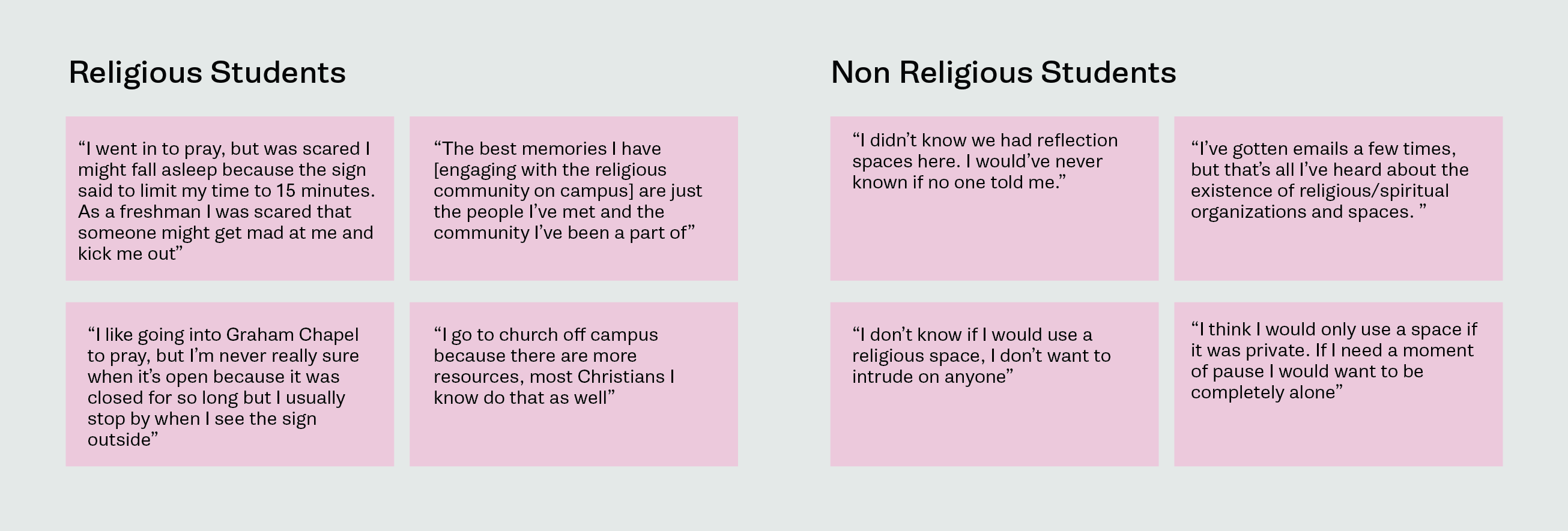

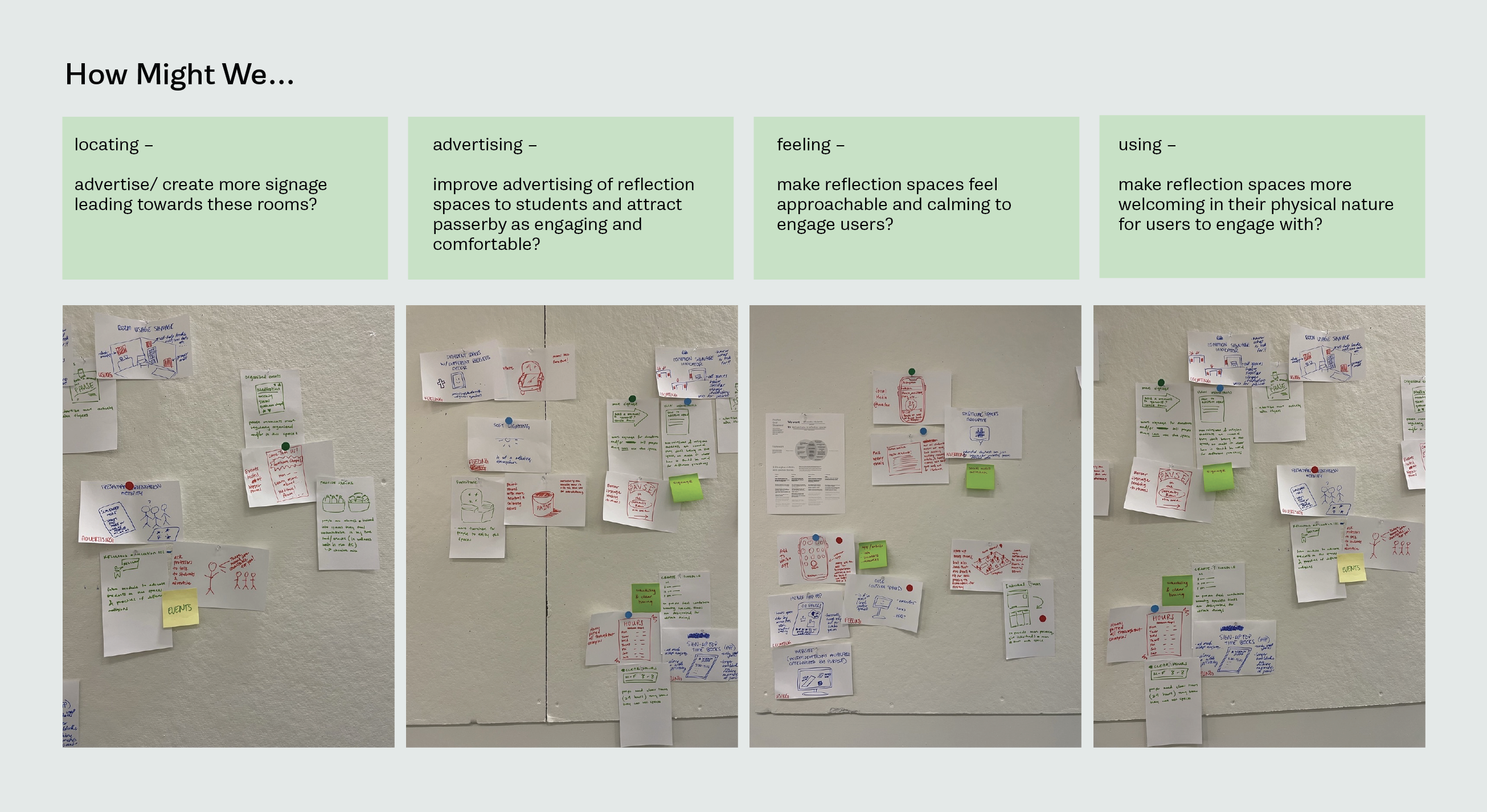

Our first step after research was to find insights based on our synthesis. Through these insights, we were able to identify four main areas for growth: locating, advertising, feeling, and using. With these four themes, we decided on “How Might We’s” and brainstormed around those HMWs.
We were most interested in the opportunity we found through primary research to raise awareness about ORSEL and its resources so that students would be more comfortable overall with the concept of Pause and the spaces offered on campus. Most students did not know that the spaces or resources existed. For those that did know about the spaces, it was clear that they did not create a welcoming atmosphere. Students were confused and unsure about how to use the spaces regardless of religious affiliation.
We brainstormed a wide a range of ideas as individuals, and later came together to group similar ideas together. By grouping our ideas, we could find common themes and create five distinct initial concepts that we collectively felt addressed the problem space.
We were most interested in the opportunity we found through primary research to raise awareness about ORSEL and its resources so that students would be more comfortable overall with the concept of Pause and the spaces offered on campus. Most students did not know that the spaces or resources existed. For those that did know about the spaces, it was clear that they did not create a welcoming atmosphere. Students were confused and unsure about how to use the spaces regardless of religious affiliation.
We brainstormed a wide a range of ideas as individuals, and later came together to group similar ideas together. By grouping our ideas, we could find common themes and create five distinct initial concepts that we collectively felt addressed the problem space.
With our initial concept ideas we went into user testing. We all interviewed students to better understand the applicability and useability of our initial ideas. We then also received feedback from professional designers to better understand our ideas from a more technical standpoint.
User feedback was particularly useful to understand those that would actually be interacting with our ideas. User feedback helped us refine our ideas and further cater to students. Our discussion guide for students focused on understanding the reality of whether or not they would interact with our concepts.
At this stage we were continuously narrowing down the ideas we wanted to pursue for our final concepts. After user testing with students we narrowed our ideas down to two options: digital outreach and physical outreach.
While getting feedback from a professional designer, we focused on refining our ideas and learning more about how our design choices might help the user in more subtle ways. We had a general visual mood board and simple prototypes and storyboards that we talked through with the designer.
User feedback was particularly useful to understand those that would actually be interacting with our ideas. User feedback helped us refine our ideas and further cater to students. Our discussion guide for students focused on understanding the reality of whether or not they would interact with our concepts.
At this stage we were continuously narrowing down the ideas we wanted to pursue for our final concepts. After user testing with students we narrowed our ideas down to two options: digital outreach and physical outreach.
While getting feedback from a professional designer, we focused on refining our ideas and learning more about how our design choices might help the user in more subtle ways. We had a general visual mood board and simple prototypes and storyboards that we talked through with the designer.

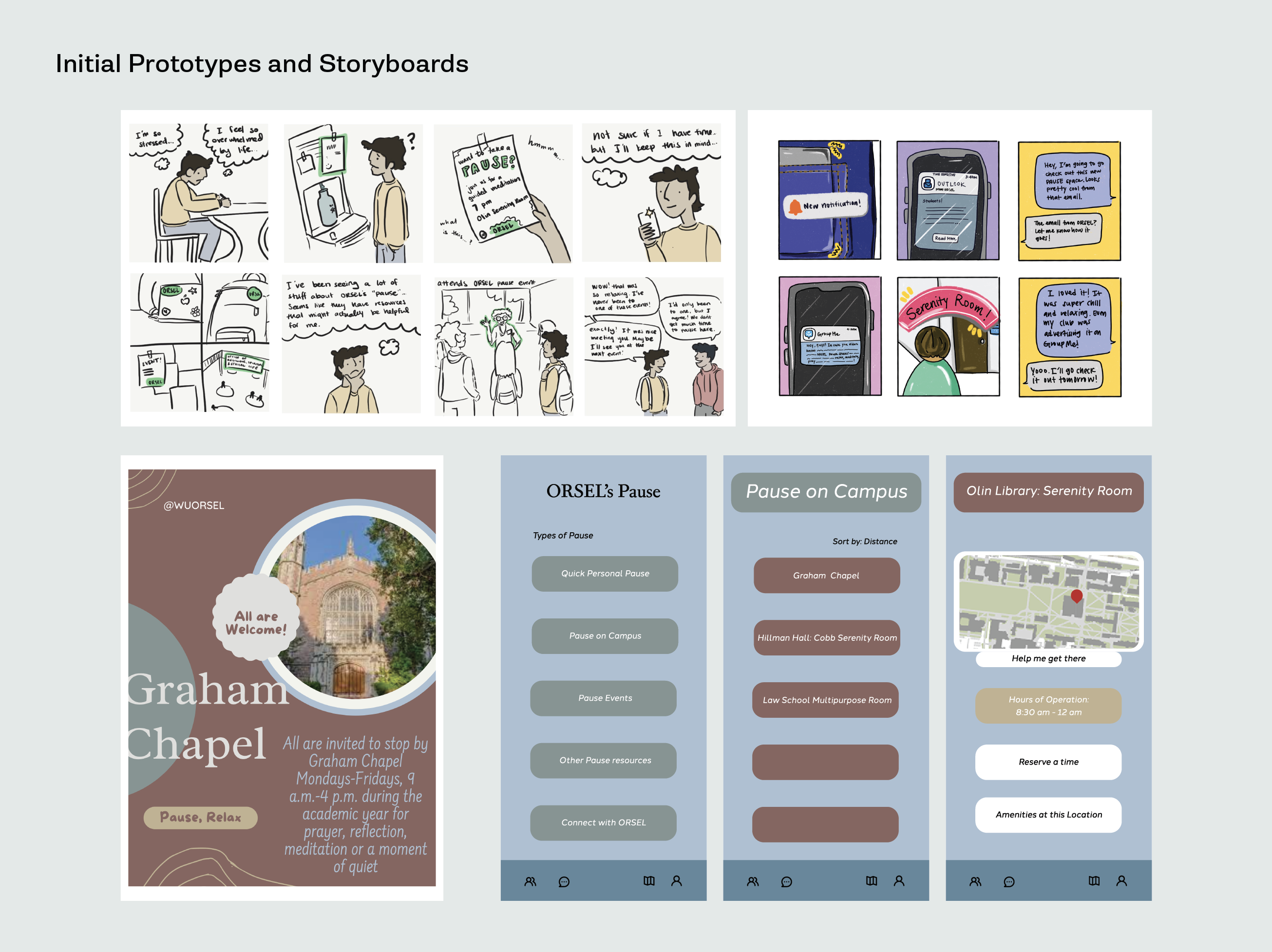
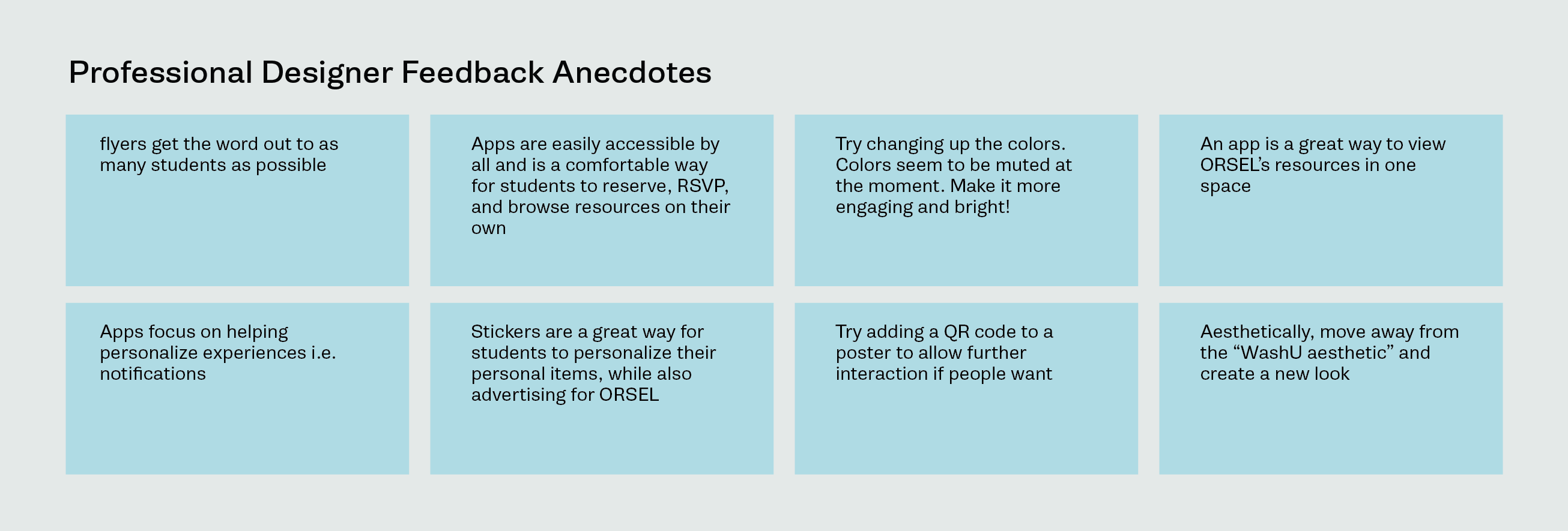

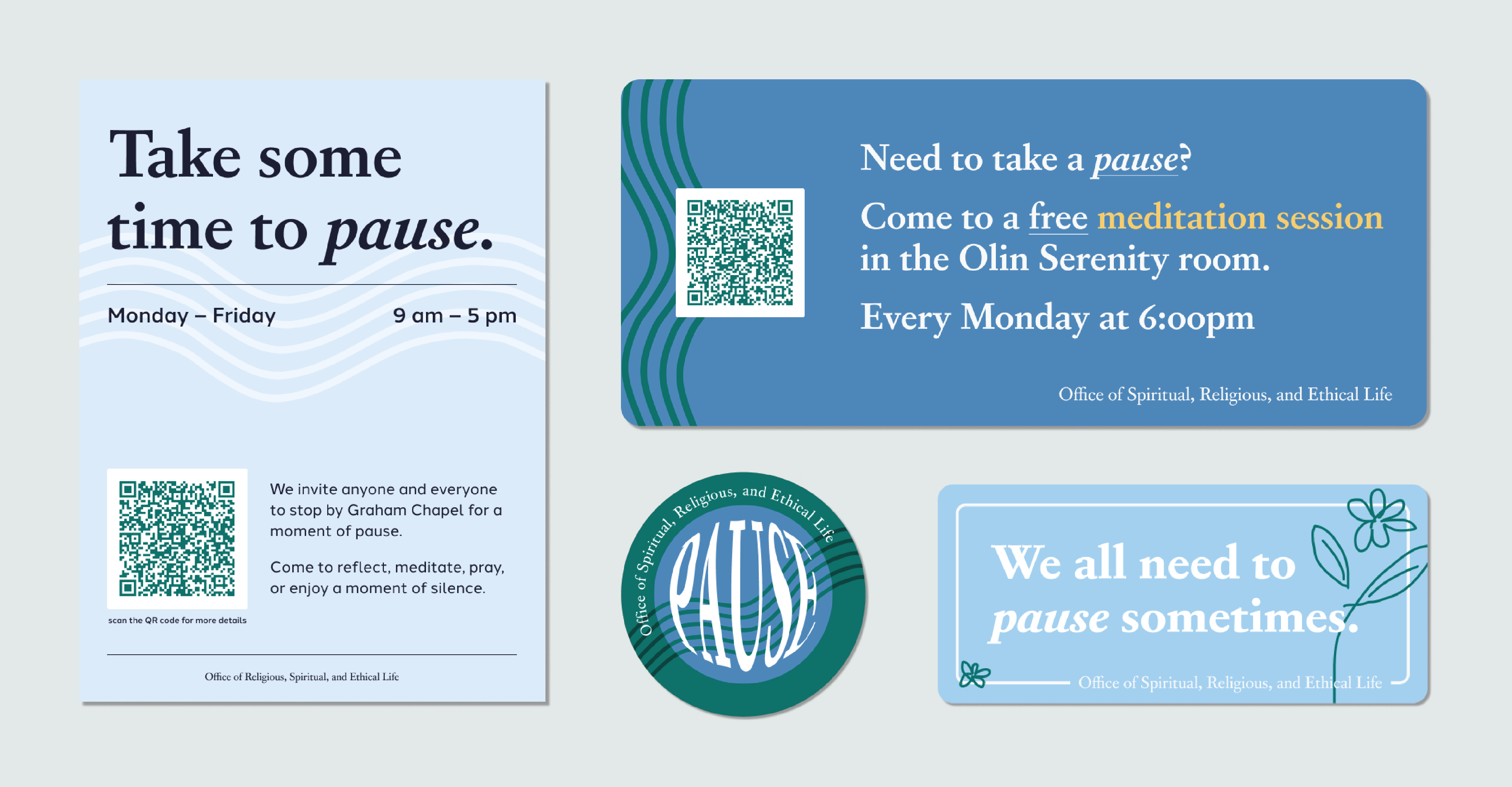
Our final two proposed concepts for ORSEL were a mobile app and physical advertising through stickers, flyers, etc.
The app allows for easy access to understanding and using ORSEL’s resourcs. We wanted to promote engagement with ORSEL spaces, so the functionalities focus on allowing students to find spaces and events on campus. Since we learned that students felt insecure and unsure about using spaces, we made it easy to book and find Pause spaces, RSVP to Pause events, and find FAQs.
The concept for phsyical advertising came mostly through our user testing. We realized that with college students, there is an overwhelming amount of information and events that one can attend. In order to engage more students, ORSEL had to make it easier for students to do so. This came down to creating a more distinct and recognizeable brand, and also pushing out more informational material.
Through our research and interviews, it was clear that offices and groups that had lots of engagement tended to have a specific brand and/or lots of promotional material (through social media or flyers). The goal of this idea was to raise awareness for specific spaces and events on campus as well as ORSEL as a whole.
The app allows for easy access to understanding and using ORSEL’s resourcs. We wanted to promote engagement with ORSEL spaces, so the functionalities focus on allowing students to find spaces and events on campus. Since we learned that students felt insecure and unsure about using spaces, we made it easy to book and find Pause spaces, RSVP to Pause events, and find FAQs.
The concept for phsyical advertising came mostly through our user testing. We realized that with college students, there is an overwhelming amount of information and events that one can attend. In order to engage more students, ORSEL had to make it easier for students to do so. This came down to creating a more distinct and recognizeable brand, and also pushing out more informational material.
Through our research and interviews, it was clear that offices and groups that had lots of engagement tended to have a specific brand and/or lots of promotional material (through social media or flyers). The goal of this idea was to raise awareness for specific spaces and events on campus as well as ORSEL as a whole.